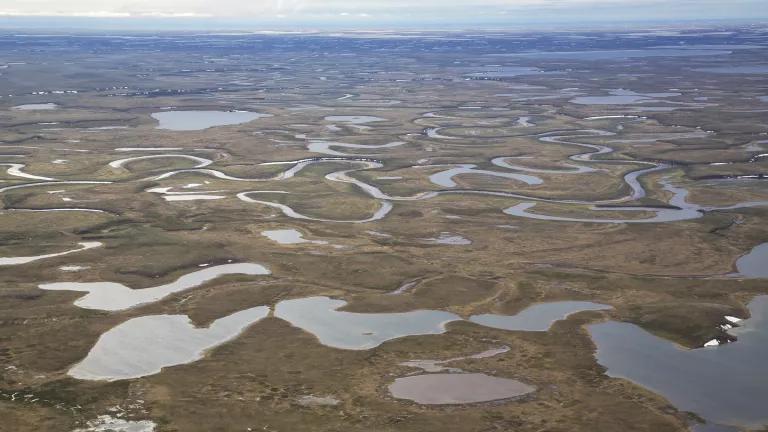White House Poised to Carbon-Bomb Its Own Climate Progress
The Willow oil drilling project—the largest single drilling project proposed on federal land—will cause roughly 280 million metric tons of carbon dioxide equivalent emissions over the course its lifetime.

Aerial view of the National Petroleum Reserve in Alaska (NPR-A)
UPDATE: On March 13, 2023, the Biden administration approved a massive expansion of oil drilling in Alaska, giving ConocoPhillips permission to begin its Willow project in the state’s western Arctic. NRDC is suing the Biden administration.
The Willow oil drilling project, proposed for Alaska’s Western Slope, is a climate doomsday carbon bomb.
What, you think that’s exaggeration? Then consider that Willow, the largest single drilling project proposed on federal land, will cause roughly 280 million metric tons of carbon dioxide equivalent (CO2e) emissions over the course its lifetime. And consider as well that the International Energy Agency has concluded that there are “no new oil and gas fields approved for development in our pathway” to limiting warming to 1.5oC, which is what’s needed to forestall the most catastrophic effects of climate change – a stark mandate counseling against any new oil drilling projects, much less unprecedentedly gargantuan ones.
The Biden administration’s climate initiatives are many and laudable. And last week, President Biden called climate change a bigger threat to humanity than nuclear weapons. Yet bafflingly, also last week, the Department of Interior indicated it was poised to approve the Willow project, which would undermine the administration’s decarbonization progress slated to be achieved through the Inflation Reduction Act and other measures.
How did we get here? And, more importantly, what can we do about it?
The problem began in previous presidential administrations, which over time granted ConocoPhillips leases in the National Petroleum Reserve in Alaska. A lease, however, is just the start of the development process, and that’s where things get interesting. Prior to sinking any wells, the leaseholder is required to submit what’s called a “master development plan” specifying exactly how and where they will proceed with drilling. And the agency tasked with approving the plan – Department of Interior’s Bureau of Land Management (BLM) – needs to prepare an environmental impact statement (EIS) comprehensively evaluating its impacts, including climate change impacts.
A federal district court blocked BLM’s first stab at an EIS in 2021, calling it inadequate and ordering the agency to try again. One of the reasons given by the court was that BLM had wrongly assumed that the lease constrained it from disallowing the project or even putting any limits on it that would have prevented ConocoPhillips from sucking every drop of available oil out of the leasehold. An EIS is supposed to consider reasonable alternatives to the project developer’s proposal, but BLM had essentially choked off the range of alternatives by striking from consideration any that would not allow the oil company to “extract all the oil and gas” it could. The court pointed out that, in fact, BLM has “its own statutory responsibility to mitigate adverse effects” of the project, and hence should have considered alternatives that would do so.
Additionally, the court flagged inadequacies in BLM’s carbon emissions analysis: the agency had whiffed on considering the emissions that would result when a good chunk of the oil from the Willow project was burned overseas.
So BLM tried again, issuing the court-ordered final supplemental EIS (SEIS) last week. And it’s another big swing and a miss. While BLM played around with the window dressing, they are still at it with the business about ConocoPhillips having the supposed unfettered right to get at all the oil that’s there. Several alternatives are dismissed from consideration, once again, on the ground that choosing them would “strand economically viable quantities of recoverable oil.” BLM has once more effectively conflated ConocoPhillips purpose for the project – maximizing profits – with its own, coming dangerously close to displaying the phenomenon known as regulatory capture.
On the issue of carbon emissions, BLM tried a lot harder this time. In this go-round, BLM identified lifecycle carbon emissions that would result from the project when the oil was burned – generating the eye-popping carbon-dioxide equivalent numbers hovering around 280 million metric tons. The agency then dutifully analyzed those emissions through several different means, some more useful than others. The SEIS presents the commonly used and rather pointless comparison of the project’s emissions to total national carbon emissions, but also this time around at least gestures at 2030 climate goals – although not in a particularly meaningful way (it’s complicated, but the upshot is that the BLM analysis fails to treat atmospheric carbon as a cumulative problem piling up over time). On the whole, BLM deployed a lot of the methods and principles articulated in the White House’s recently-issued interim guidance for assessing greenhouse gas emissions in environmental reviews.
This more detailed analysis of the project’s colossal carbon impact is of little help, however, given that BLM has hamstrung itself from actually doing anything about it. By insisting that it can’t consider any alternative that would leave some or all of the economically recoverable oil in the ground, BLM limited its choices to four alternatives with almost the exact same total carbon emissions; plus the “no action” alternative that it was legally obligated to include as a baseline, but may or may not be actually considering as a possibility.
The SEIS identifies one alternative – “Alternative E” – as its preferred alternative, meaning the one it would be recommending for adoption if the project moves forward. Alternative E would allow fewer drill sites, temporarily deferring development of one of them and reducing the physical size of the project’s footprint on the land. But although some early reports characterized this alternative as “scaled back” and “limited” there is nothing much limited about it on the climate change front. Where ConocoPhillips’ proposal would generate about 284 million metric tons of carbon dioxide equivalent emissions, Alternative E would generate about 278 million metric tons – a whopping 2 percent reduction. It’s a fix whose effectiveness compares unfavorably to Titanic deck chair rearrangement.
But Alternative E is not a final decision, it is only a recommendation. The final decision can’t be made until at least 30 days after the SEIS was published last week, meaning there is still time for the White House and Department of the Interior to recognize that the Willow Project is a truly awful idea and put the kibosh on it. And there are glimmers of hope for this possibility in the administration’s own statements about the project, which are unusually ambivalent about it. The Department of Interior said in an official statement that it “has substantial concerns about the Willow project and the preferred alternative as presented in the final SEIS, including direct and indirect greenhouse gas emissions and impacts to wildlife and Alaska Native subsistence.” The statement specifically noted that the identification of a preferred alternative is “not a decision about whether to approve the Willow Project.” White House press secretary Karine Jean-Pierre drove the point home at a press conference last week, stating, “Let me just be clear: No decision has been made on this.”
Rejecting a project in its entirety for which an EIS has been prepared would not exactly be business as usual. But if there was ever a time when we need to reverse course on business as usual, it’s now.




